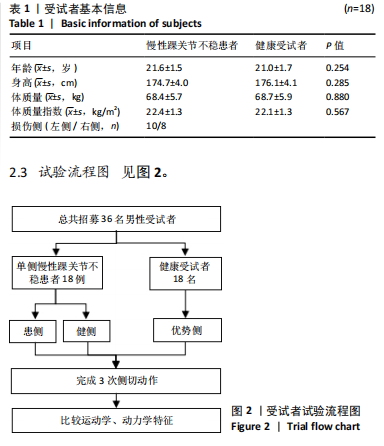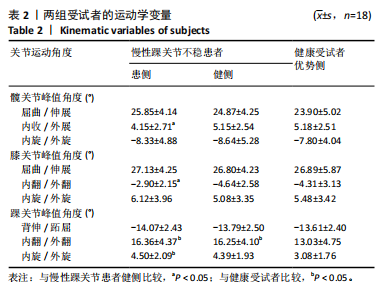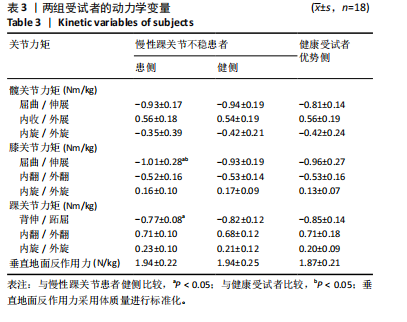[1] ROOS KG, KERR ZY, MAUNTEL TC, et al. The Epidemiology of Lateral Ligament Complex Ankle Sprains in National Collegiate Athletic Association Sports. Am J Sports Med. 2017;45(1):201-209.
[2] KUDO S, AOYAGI T, KOBAYASHI T, et al. Ultrasound Imaging of Subtalar Joint Instability for Chronic Ankle Instability. Healthcare (Basel). 2023; 11(15):2227.
[3] WIKSTROM EA, BROWN CN. Minimum reporting standards for copers in chronic ankle instability research. Sports Med. 2014;44(2):251-268.
[4] DOHERTY C, BLEAKLEY C, HERTEL J, et al. Recovery From a First-Time Lateral Ankle Sprain and the Predictors of Chronic Ankle Instability: A Prospective Cohort Analysis. Am J Sports Med. 2016;44(4):995-1003.
[5] HERTEL J, CORBETT RO. An Updated Model of Chronic Ankle Instability. J Athl Train. 2019;54(6):572-588.
[6] SIMPSON JD, STEWART EM, RENDOS NK, et al. Anticipating ankle inversion perturbations during a single-leg drop landing alters ankle joint and impact kinetics. Hum Mov Sci. 2019;66:22-30.
[7] DOHERTY C, BLEAKLEY C, HERTEL J, et al. Single-leg drop landing movement strategies in participants with chronic ankle instability compared with lateral ankle sprain ‘copers’. Knee Surg Sports Traumatol Arthrosc. 2016;24(4):1049-1059.
[8] KIM H, SON SJ, SEELEY MK, et al. Altered Movement Biomechanics in Chronic Ankle Instability, Coper, and Control Groups: Energy Absorption and Distribution Implications. J Athl Train. 2019;54(6):708-717.
[9] SIMPSON JD, KOLDENHOVEN RM, WILSON SJ, et al. Ankle kinematics, center of pressure progression, and lower extremity muscle activity during a side-cutting task in participants with and without chronic ankle instability. J Electromyogr Kinesiol. 2020;54:102454.
[10] SIMPSON JD, STEWART EM, MACIAS DM, et al. Individuals with chronic ankle instability exhibit dynamic postural stability deficits and altered unilateral landing biomechanics: A systematic review. Phys Ther Sport. 2019;37:210-219.
[11] KIM H, SON SJ, SEELEY MK, et al. Kinetic Compensations due to Chronic Ankle Instability during Landing and Jumping. Med Sci Sports Exerc. 2018;50(2):308-317.
[12] PETERKA RJ. Sensory integration for human balance control. Handb Clin Neurol. 2018;159:27-42.
[13] HU X, FENG T, LI P, et al. Bilateral Sensorimotor Impairments in Individuals with Unilateral Chronic Ankle Instability: A Systematic Review and Meta-Analysis. Sports Med Open. 2024;10(1):33.
[14] KHALAJ N, VICENZINO B, HEALES LJ, et al. Is chronic ankle instability associated with impaired muscle strength? Ankle, knee and hip muscle strength in individuals with chronic ankle instability: a systematic review with meta-analysis. Br J Sports Med. 2020;54(14):839-847.
[15] SONG K, JANG J, NOLTE T, et al. Dynamic reach deficits in those with chronic ankle instability: A systematic review and meta-analysis. Phys Ther Sport. 2022;53:40-50.
[16] SOUSA A SP, SILVA M, GONZALEZ S, et al. Bilateral compensatory postural adjustments to a unilateral perturbation in subjects with chronic ankle instability. Clin Biomech (Bristol). 2018;57:99-106.
[17] SIMPSON JD, RENDOS NK, STEWART EM, et al. Bilateral spatiotemporal postural control impairments are present in participants with chronic ankle instability. Phys Ther Sport. 2019;39:1-7.
[18] WARD S, PEARCE AJ, PIETROSIMONE B, et al. Neuromuscular deficits after peripheral joint injury: a neurophysiological hypothesis. Muscle Nerve. 2015;51(3):327-332.
[19] SOUSA A SP, LEITE J, COSTA B, et al. Bilateral Proprioceptive Evaluation in Individuals With Unilateral Chronic Ankle Instability. J Athl Train. 2017;52(4):360-367.
[20] SUTTMILLER AMB, MCCANN RS. Neural excitability of lower extremity musculature in individuals with and without chronic ankle instability: A systematic review and meta-analysis. J Electromyogr Kinesiol. 2020;53: 102436.
[21] HILLER CE, REFSHAUGE KM, BUNDY AC, et al. The Cumberland ankle instability tool: a report of validity and reliability testing. Arch Phys Med Rehabil. 2006;87(9):1235-1241.
[22] CHEN P, WANG L, DONG S, et al. Can Symmetry of Single-Leg Vertical Jump Height Represent Normal Lower Limb Biomechanics of Athletes After Anterior Cruciate Ligament Reconstruction? Sports Health. 2024; 16(4):596-605.
[23] 陈鹏, 左会武, 王玲, 等. 前交叉韧带重建术后运动员单腿垂直跳跃高度对称性掩盖其异常下肢生物力学[J]. 中国运动医学杂志, 2023,42(12): 939-947.
[24] WANG L, CHEN P, DING Y, et al. Effects of Kinesio taping on lower limb biomechanical characteristics during unexpected jumping in patients with chronic ankle instability. Scand J Med Sci Sports. 2024;34(1): e14566.
[25] ZHANG S, WANG L, LIU X, et al. Effects of Kinesio taping on lower limb biomechanical characteristics during the cutting maneuver in athletes after anterior cruciate ligament reconstruction. PLoS One. 2024;19(3): e0299216.
[26] LEE H, HAN S, HOPKINS JT. Balance Training With Stroboscopic Glasses and Neuromechanics in Patients With Chronic Ankle Instability During a Single-Legged Drop Landing. J Athl Train. 2024;59(6):633-640.
[27] LEPLEY LK, WOJTYS EM, PALMIERI-SMITH RM. Combination of eccentric exercise and neuromuscular electrical stimulation to improve biomechanical limb symmetry after anterior cruciate ligament reconstruction. Clin Biomech (Bristol). 2015;30(7):738-747.
[28] PANAGIOTAKIS E, MOK KM, FONG DT, et al. Biomechanical analysis of ankle ligamentous sprain injury cases from televised basketball games: Understanding when, how and why ligament failure occurs. J Sci Med Sport. 2017;20(12):1057-1061.
[29] GEHRING D, WISSLER S, LOHRER H, et al. Expecting ankle tilts and wearing an ankle brace influence joint control in an imitated ankle sprain mechanism during walking. Gait Posture. 2014;39(3):894-898.
[30] LI Y, KO J, ZHANG S, et al. Biomechanics of ankle giving way: A case report of accidental ankle giving way during the drop landing test. J Sport Health Sci. 2019;8(5):494-502.
[31] REMUS A, CAULFIELD B, DOHERTY C, et al. A laboratory captured “giving way” episode in an individual with chronic ankle instability. J Biomech. 2018;76:241-246.
[32] ZHANG Z, ZHANG M. Effect of different ankle braces on lower extremity kinematics and kinetics following special-induced fatigue for volleyball players with functional ankle instability. Heliyon. 2023;9(6):e16380.
[33] SIMPSON JD, STEWART EM, MOSBY AM, et al. Lower-Extremity Kinematics During Ankle Inversion Perturbations: A Novel Experimental Protocol That Simulates an Unexpected Lateral Ankle Sprain Mechanism. J Sport Rehabil. 2019;28(6):593-600.
[34] SIMPSON JD, STEWART EM, TURNER AJ, et al. Neuromuscular control in individuals with chronic ankle instability: A comparison of unexpected and expected ankle inversion perturbations during a single leg drop-landing. Hum Mov Sci. 2019;64:133-141.
[35] HERB CC, GROSSMAN K, FEGER MA, et al. Lower Extremity Biomechanics During a Drop-Vertical Jump in Participants With or Without Chronic Ankle Instability. J Athl Train. 2018;53(4):364-371.
[36] KIKUMOTO T, SUZUKI S, TAKABAYASHI T, et al. Center of Pressure Deviation during Posture Transition in Athletes with Chronic Ankle Instability. Int J Environ Res Public Health. 2023;20(8):5506.
[37] ALKASLASI MR, PICCUS ZE, HAREENDRAN S, et al. Single nucleus RNA-sequencing defines unexpected diversity of cholinergic neuron types in the adult mouse spinal cord. Nat Commun. 2021;12(1):2471.
[38] HILLER CE, NIGHTINGALE EJ, LIN CW, et al. Characteristics of people with recurrent ankle sprains: a systematic review with meta-analysis. Br J Sports Med. 2011;45(8):660-672.
[39] SON SJ, KIM H, SEELEY MK, et al. Movement Strategies among Groups of Chronic Ankle Instability, Coper, and Control. Med Sci Sports Exerc. 2017;49(8):1649-1661.
[40] KIM H, SON SJ, SEELEY MK, et al. Altered movement strategies during jump landing/cutting in patients with chronic ankle instability. Scand J Med Sci Sports. 2019;29(8):1130-1140.
[41] CUYUL-VáSQUEZ I, ÁLVAREZ E, RIQUELME A, et al. Effectiveness of Unilateral Training of the Uninjured Limb on Muscle Strength and Knee Function of Patients With Anterior Cruciate Ligament Reconstruction: A Systematic Review and Meta-Analysis of Cross-Education. J Sport Rehabil. 2022;31(5):605-616.
[42] HALE SA, FERGUS A, AXMACHER R, et al. Bilateral improvements in lower extremity function after unilateral balance training in individuals with chronic ankle instability. J Athl Train. 2014;49(2):181-191.
[43] CIRER-SASTRE R, BELTRáN-GARRIDO JV, CORBI F. Contralateral Effects After Unilateral Strength Training: A Meta-Analysis Comparing Training Loads. J Sports Sci Med. 2017;16(2):180-186.
[44] RUDDY KL, LEEMANS A, WOOLLEY DG, et al. Structural and Functional Cortical Connectivity Mediating Cross Education of Motor Function. J Neurosci. 2017;37(10):2555-2564.
[45] ABBOTT EM, STEPHENS JD, SIMHA SN, et al. Attenuation of muscle spindle firing with artificially increased series compliance during stretch of relaxed muscle. Exp Physiol. 2024;109(1):148-158.
[46] WU X, SONG W, ZHENG C, et al. Morphological study of mechanoreceptors in collateral ligaments of the ankle joint. J Orthop Surg Res. 2015;10:92.
[47] ZHANG R, ZHANG X, CHEN Y, et al. Current perception threshold testing in chronic ankle instability. BMC Musculoskelet Disord. 2021;22(1): 453.
|



